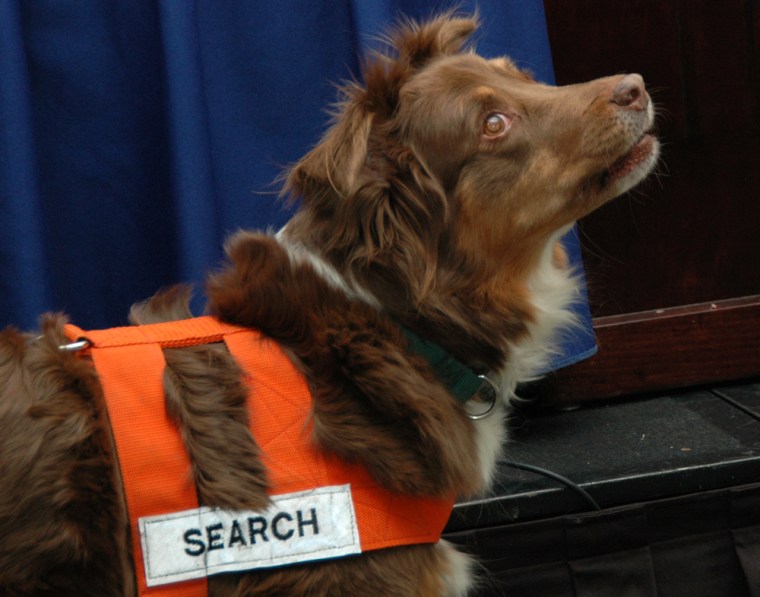It takes less than a minute for Glory to locate the human remains hidden amid a roomful of journalists — but there are some things even Glory, an Australian shepherd dog that’s been searching through crime scenes for years, can’t do.
"The expectations for cadaver search dogs, for absolute perfection, have drastically gone up," said Jane Servais, Glory's owner and president of the Mid-Atlantic D.O.G.S., a canine search-and-rescue group.
Glory and her human counterparts in crime scene investigation are all having to cope with an age of heightened expectations, brought on by the gee-whiz science seen in TV shows such as “CSI.” During presentations here at the annual meeting of the American Association for the Advancement of Science, forensic experts noted that the surge of attention even had a prime-time name: the “CSI” Effect.
If only there were as much attention devoted to basic research in the field, they lamented.
Rise in popular interest
Not that the attention is all bad: More and more students are enrolling in crime-lab classes, said Max Houck, director of the Forensic Science Initiative at West Virginia University. At a news briefing Sunday, Houck noted that the forensic program had just four graduates in 1999. Today it's the largest major program on campus, with about 400 undergraduate students.
But once those students start working in the field, they face pressures from the families of crime victims and others who expect test results to come as easily and infallibly as they do on television. The popularity of high-tech crime analysis has led law enforcement agencies to submit increasing numbers of samples for testing, resulting in a backlog of 200,000 to 300,000 DNA samples alone, Houck said.
The “CSI” Effect has affected other parts of the legal system as well.
"Prosecutors tend to fear the 'CSI' Effect on juries, because juries now have an unrealistic expectation of what the laboratory will do. They wonder why wasn't everything tested, when in fact not everything needs to be tested," Houck said. "Defense attorneys now worry about the 'CSI' Effect as well, because they think that the jurors come in and have this view of science as this juggernaut, this infallible objective method that is always right and spells doom for their client."
TV vs. reality
Houck said the TV plots have become so glib about the science that he can't watch “CSI” or other crime-investigation dramas anymore. "If I do, I just break out in hives," he joked.
Patricia McFeely, a forensic pathologist at the University of New Mexico Health Sciences Center, said she was particularly put off by the way the TV investigators always seem to be able to figure out exactly what happened when, right down to determining the time of death to the minute.
"They never have to go to the literature, as we do," she said.
What real-life sleuths need
Houck said there was a crying need for more basic research, particularly into methods other than DNA testing, such as fingerprint analysis. DNA testing is "the more attractive younger sibling and it got more attention, and some of the older siblings were ignored," he said.
He said the federal government provided just $12 million to $15 million annually for forensic science research, through the National Institute of Justice.
"There is more money spent in this country on holistic medicine every year than there is on forensic science research, and I find that appalling for any number of reasons," Houck said.
Despite the grumbling, the experts conceded that the real-life routine of a crime investigator probably wouldn't get the kinds of TV ratings "CSI" and "Law and Order" do.
"As I tell my students, it's less about wearing leather pants and driving Hummers than it is about wearing a Tyvek jumpsuit and crawling under somebody's porch and looking for body parts," Houck said. "That's the reality of it."
Sniffing out clues
Jane Servais and her dog Glory provided a taste of that forensic reality for journalists at Sunday's briefing.
Before the event, Servais hid a glass jar containing several extracted human teeth, donated by a dentist for training purposes. Then she brought Glory into the room, passing by rows of seated journalists. "If she starts barking at you, that's a bad sign," Servais remarked.
At the appointed time, the dog was set to work. Glory paced around the front of the room, sniffing one spot after another, and it didn't take long for her to stop at a corner of the speaker's table, look up at Servais and start yipping.
"Show me!" Servais said. Glory jumped up on the table. Sure enough, the jar with the teeth had been placed underneath that corner of the table.
Servais said no high-tech sensor could match the nose of a trained canine when it comes to catching the scent of human remains — although some researchers might debate that claim. Servais and Glory have helped out with a wide variety of crime-scene cases in the Washington area, including the aftermath of the 9/11 terror attack on the Pentagon.
There are some challenges Servais and Glory won't take on: For instance, Servais has turned down requests to search for Civil War-era remains, or look for the buried remains of infants years after their disappearance, because in those cases there wouldn't be enough of a scent left behind even for Glory's sensitive nose.
And then there are times when even cadaver-sniffing dogs just have an off day.
"If they're uncomfortable at all, they're not as well-focused, and if they're not focused they're not as effective," Servais said. "That's when, as a handler, you've got to pull them out."
